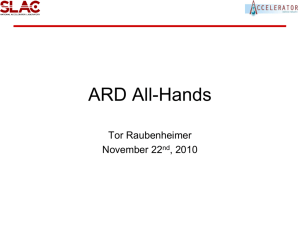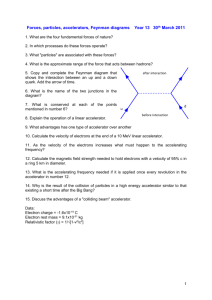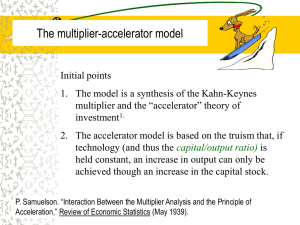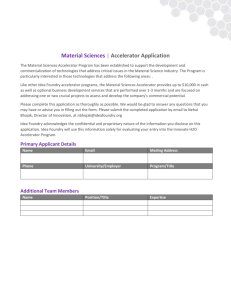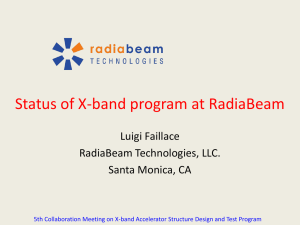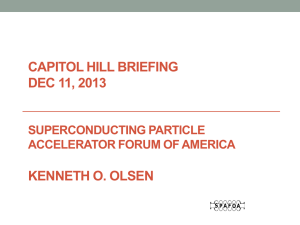20130311-GARD-XTA-Raubenheimer
advertisement
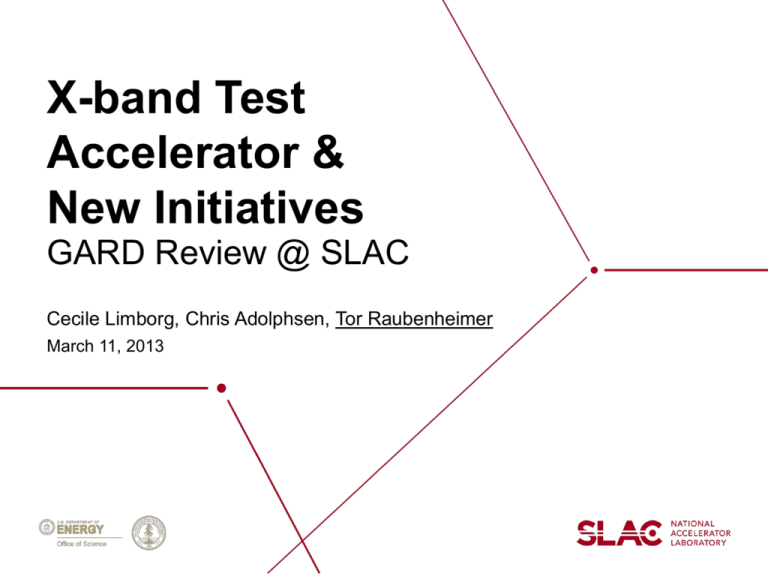
X-band Test Accelerator & New Initiatives GARD Review @ SLAC Cecile Limborg, Chris Adolphsen, Tor Raubenheimer March 11, 2013 X-Band Test Accelerator (XTA) Generation of high brightness beams is a key accelerator technology Goals for the XTA: • High brightness injector (beams accelerated to 100 MeV) - Study an approach to very high brightness beams • Compact X-band linac - Study operational issues (timing, alignment, …) • Use facility to support new initiatives Construct XTA leveraging existing infrastructure • Installed in NLCTA enclosure, uses control room and rf sources • Based on LCLS design; uses LCLS high-level controls & applications Based on 20 years of X-band rf development 2013 General Accelerator R&D Review 2 NLCTA Facility 50 meter shielded enclosure containing NLCTA and XTA. Facility has 4 X-band rf sources, 1 S-band rf gun, 1 X-band rf gun, 3 laser systems and supports a variety of acceleration and beam physics R&D activities ~50 meters 2013 General Accelerator R&D Review 3 X-band Test Accelerator Compact (~6 meters) Injector Beamline 2013 General Accelerator R&D Review 4 High Brightness Electron Sources State-of-the-art Groups around the world are pushing on e- source brightness • Peak and average brightness • Focus on peak brightness largely driven by next generation radiation sources: SwissFEL, PALFEL, MARIE, MEGA-ray, … Two separate issues: transverse and longitudinal phase space • LCLS S-band gun From Aug, 2008 ICFA BD Newsletter pushes both • Cathodes will likely yield further improvements but gun is still limitation Recently, strong focus on lower charge bunches Q << 1 nC • Naturally matched to higher frequency rf guns 2013 General Accelerator R&D Review 5 High Brightness Electron Guns What are the next Steps? LCLS S-band rf injector performs extremely well How to improve peak brightness? • Many incremental improvements (better field comp, load lock, …) • No concrete ideas for factor of 2 much less a factor of 10 What about different approaches? • DC photo-injector (reduced space charge and emittance from gun) • Low rf frequency gun (reduced field tolerances and peak current) • High gradient rf gun (reduced space charge and bunch length) X-band rf gun offers factor of ~8 improvement in brightness (in simulation) but will be challenging to implement • Broad synergies with other programs across SLAC 2013 General Accelerator R&D Review 6 RF Gun Emittance and Brightness Scaling Benefits of shorter Wavelength Simple scalings of emittance and brightness suggest: B ~ 1/l2 and ge ~ l where Q ~ l and sz ~ l From J. Rosenzweig modified by Feng Zhou for LCLS Many applications are optimizing toward lower charge beams Emittance vs. Charge • LCLS was designed for 1 nC and typically operates at 150 pC • Natural for high rf frequency gun 2013 General Accelerator R&D Review 7 Mark-1 X-band RF Gun Joint SLAC-LLNL Collaboration First X-band gun design was built and tested at SLAC in mid-2000’s Mark-1 incorporates lessons from LCLS • Racetrack coupler; increased mode separation; elliptical iris shape 2013 General Accelerator R&D Review 8 RF Gun Simulation Studies X-band gun 8x higher Brightness ASTRA simulations results (after multi-parameter optimization) Q [pC] 250 250 20 10 10 1 1 X-Band Test Acc. (Simulations) LCLS (Simulations and measurements) ex,95% [mm-mrad] 0.25 0.28 0.075 0.076 0.118 0.016 0.036 ex,95% [mm-mrad] sl [mm] Bpeak= Q/sl/e2/1e3 0.40 0.15 0.620 0.220 2.52 4.04 sl [mm] Bpeak= Q/sl/e2/1e3 0.228 17.5 0.184 17.3 0.109 32.6 0.055 31.5 0.042 17.1 0.080 48.8 0.025 30.9 High ERF,cathode to beat surface self-field and reach smaller rlaser and thus smaller e┴ High dEz / dt for short bunches rlaser Qe o ERF ,cathode Cecile Limborg 2013 General Accelerator R&D Review 9 XTA Beamline Diagnostics The XTA was built with extensive diagnostics similar to LCLS • Beam will be accelerated to over 70 MeV to reduce space charge • Includes 3 YAG and 3 OTR screens, large angle spectrometer, transverse deflecting cavity, rf BPMs to align structure Goal is to fully characterize the brightness of the X-band injector 8 MeV Gun 200 MV/m Solenoid YAG/ FC 70 ~ 100 MeV T105 ~100 MV/m TD11 (TCAV) 3MV FC YAG/OTR FC Cavity BPMs 2013 General Accelerator R&D Review OTR YAG/OTR Spectrometer 4 Quadrupoles with BPMs Cecile Limborg 10 XTA Hardware Project started in 2011 TCAV Starting with Mark-0 rf gun and old T105 accelerator structure Mark-1 rf gun View from dump • Mark-1 is fabricated • New T105 is almost ready YAG, Laser Injection chamber 2013 General Accelerator R&D Review Linac Cecile Limborg 11 XTA Commissioning Results As of end of February, 2013 XTA routinely operated with charges up to 30-40 pC Energy at ~8 MeV from gun and ~70 MeV out of linac Transverse deflector installed and commissioned Bunch lengths measured to be 250 fs rms for ~20pC, in agreement with simulations Tuning to small emittances is sensitive to strong jitter and low OTR light level • Laser noise reduced from 350-500 fs rms down to 70 fs rms • Contribution modulator HVPS measured ~175ppm rms (ie dF~ 0.6 deg rms, • dV/V ~3e-4); Contribution from LLRF still under investigation OTR replaced by combined dual YAG/OTR Low charge studies • QE relatively low; increased by lengthening laser pulse • Plans to measure thermal emittance and maybe laser cleaning 2013 General Accelerator R&D Review Cecile Limborg 12 Future XTA Commissioning Timeline Complete commissioning in FY2013 Goal: demonstrate injector performance by end of 2013 Continue with Mark-0 rf gun through August, 2013 • Measure cathode properties: QE and thermal emittance; try • • laser cleaning Work on improving jitter sources: LLRF and modulators Optimize slice emittance and bunch length Install Mark-1 rf gun and new T105 in August down • Measure cathode properties: QE and thermal emittance • Optimize slice emittance and bunch length Program is interlaced with other NLCTA efforts • Operate a shift per day roughly 50% of time 2013 General Accelerator R&D Review 13 New Initiatives with X-band RF Gun Inverse Compton Source and Ultra-fast Electron Diffraction The high brightness source will enable many future programs • • • • Improved beams for E-163 or Echo-75 at the NLCTA or LCLS or FACET MEGA-ray experiments at LLNL (or SLAC) An Inverse Compton Source at XTA An Ultra-fast Electron Diffraction source at XTA Ultra-fast Electron Diffraction • Large dEz / dt in gun will allow large velocity compression of bunch • X-Band technology (gun + compressor) promises REGAE @ DESY - 1pC, few fs rms with divergence < 0.5 mrad - 8pC, 20 fs rms Siwick @ McGill • 2-3 orders of magnitude better than present technology 2013 General Accelerator R&D Review 14 Why Inverse Compton Scattering (ICS)? Narrow bandwidth and high spectral brilliance Bremstrahlung Channeling Compton Undulator Eg ~ 0 – Eb Eg ~ 100g3/2 Eg ~ 4g2 Eg ~ 2x10-4g2 100% BW 10% BW 1~0.1% BW 0.1% BW High flux Moderate flux Low flux Moderate flux Narrow spectral bandwidth key to improving S/N 2013 General Accelerator R&D Review 15 Inverse Compton Source Characteristics Two features of ICS source make it very powerful » Easy variation of photon energy (pulse-by-pulse, if desired) » Scan resonances, contrast enhahncement, etc. » Narrow bandwidth with highly correlated Eg and q » Core spectral width is ~0.1% improved S/N and reduced dose Wide set of possible applications ranging from medical (oncology & imaging), industrial (spectroscopy & imaging), science and security 2013 General Accelerator R&D Review 16 Inverse Compton Scattering Sources Two primary approaches to beam generation: » Ring-based with high rep rate but larger emittance » Linac-based with brighter beams • SCRF linac has benefits of both ThomX ICS design » Very different technical challenges Brightness of source depends on electron source brightness For high energy g’s a linac is likely to provide a compact cost-effective path Many applications are dose limited and don’t require huge fluxes MIT ICS design 2013 General Accelerator R&D Review 17 Some Existing or Planned ICS Facilities Facility PLEIADES (LLNL) AIST LCS (Japan) LUCX (Quantum Beam) *NERL (UTNL, Tokyo) *MIT *MXI Systems (Tennessee) *PLASMONX (SPARC, Italy) Lyncean Tech (California) *NESTOR (Kharkov IPT) *ThomX (France) Type X-ray E (keV) Rep. Rate (Hz) Bunches/ pulse Source size† (mm rms) Linac 10-100 10 1 10 108 Linac 10-40 10 1-100 40 107-109 SC linac ~5-50 12.5 Hz Linac 10-80 10 SC linac 3-30 108 1 Linac 8-100 10 1 Linac 20-380 10 1 100 (future 8x103) 104 10% BW 4-10% BW 8 ?? 75 x 60 109-2x1010 few % BW 2.4 1014 25% BW (>1015 future ERL, FEL?) 5-10 ring 7-35 65 x 106 1 30-50 ring ~6-900 20-700 x 106 1 35 ring 50-90 21 x 106 1 40-70 2013 General Accelerator R&D Review Spectral flux (approx.) (ph/s/% BW) 1010 10% BW 109 ~10% BW (future FEL?) 109 3-4% BW (future 5 x 1011) ?? 1013 25% BW 18 Scientific Opportunities with ICS Examples of Applications Developing a compact source with modest flux at high photon energy will complement DOE SR light sources • It would provide a relatively compact (room sized) system at a moderate cost but with high performance needed for research http://www.emsl.pnnl.gov/root/publications/docs/compact_xray.pdf 2013 General Accelerator R&D Review Anne Sakdinawat, Yijin Liu, Mike Toney Impact (Beyond Office of Science) Example: Understanding lifecycle of rare earth elements New Critical Materials Hub recently created at DOE EERE • “… challenges in critical materials, including mineral processing, manufacture, substitution, efficient use, and end-of-life recycling; …” Rare earth K-shell binding energies range from 4 to 65 keV • A moderate energy ICS would penetrate typical core samples An ICS-based microscopy system could be instrumental as an experimental tool in the analysis of the morphology and composition of rare earth materials throughout their life cycle. 2013 General Accelerator R&D Review Anne Sakdinawat, Yijin Liu, Mike Toney 20 Impact (Beyond Office of Science) Example: Understanding Carbon Sequestration and Storage Goal: understand the flow and storage of hydrocarbons • Determine generative potential and pay type (i.e., gas vs. oil) to catalog the organic resources This type of investigation needs to be carried out at different length scales (resolution from ~mm to micron-level to 30 nanometers) Desired features of the source: 1. High beam energy (for penetrating large specimens) 2. Brightness (for desired resolution) 3. Energy tunability (in order to retrieve elemental distribution) Anne Sakdinawat, Yijin Liu, Mike Toney 2013 General Accelerator R&D Review 21 Impact (Beyond Office of Science) Example: Microbeam Radiation Therapy (MRT) Goal: Radiosurgery with reduced impact to surrounding tissue • Microbeam Radiation Therapy (MRT) Serduc, et al., PLoS One. 2010 Feb 3;5(2): e9028 has been studied at BNL and ESRF: Dilmanian, et al., Natl Acad Sci 2006 Jun 20;103(25):9709-14; Serduc, et al., PLoS One. 2010 Feb 3;5(2): e9028. • “Growing experimental evidence is showing remarkable tolerance of brain and spinal cord to irradiation with microbeam arrays delivering doses up to 400 Gy with a beam width up to 0.7 mm” (Neurol Res. 2011 Oct;33(8):825-31) • Rat studies performed with 100 ~ 350 keV photons; need ~MeV x-rays for people. • ICS would be a possible, compact source 2013 General Accelerator R&D Review 22 Inverse Compton Experiment at X-band (ICE-X) Goal: high brightness gamma beam for precision experiments • Optimizing the system with photon science/medical school experts Flux of >107 g/s of 0.1 ~ 2 MeV photons with B >109 (g/s/mm2/mrad2/0.1%) • Narrow bandwidth achieved with high brightness beam and long-pulse laser interaction reasonable beam and laser parameters - Commercially available 10 Hz, 3J, 3ns, YAG pump laser with 30 um laser waist - (I0 ~ 1x1014 W/cm2) 5 cm e- beta, 250 pC, ge < 0.4 mm-mrad • Stable beam and laser simpler operating conditions Upgrades to increase flux & brightness by >1000 • Upgrade laser to 120 Hz • Operate with multibunch train (30 bunches / rf pulse) 2013 General Accelerator R&D Review 23 Inverse Compton Experiment at X-band (ICE-X) Build on the XTA Build on the X-band Test Area (100 MeV X-band photo-injector) • Build experimental hutch and borrow interaction laser • Lengthen accelerator to generate 235 MeV e- 2 MeV g’s Support for hutch and experiments from external programs • Start with staged approach to illustrate feasibility NLCTA Enclosure Echo-75 beamline XTA/ICS beamline 2013 General Accelerator R&D Review NLCTA Dump Experimental hutch (upgrade for Echo beamline as well) Staged Construction of ICE-X ICE-Lite (FY2014 – FY2015) Start from 100 MeV XTA configuration • • • • • • Complete XTA injector demonstration – October, 2013 Borrow YAG pump laser system (3J, 3ns, 10 Hz at 1 um) Add IR and laser to generate g’s – March, 2014 Start construction of g-hutch – July, 2014 Operate ICS at 50 to 200 keV – Sept, 2014 Upgrade with multibunch and laser rep. rate for 1000x flux and brightness – FY2015 Upgrade linac to 235 MeV ICE-X • Install old T105 and two additional T55 structures • Double klystrons in Station 2 2013 General Accelerator R&D Review 25 Summary Quality and impact of research over the last four years: • Working on new e- source with order-of-magnitude improvement in brightness • XTA has gone from concept to beamline in <2 years and commissioning has begun Expected deliverables over the next 5-10 years: • Demonstration of a new high brightness electron source - Key accelerator technology • Utilization of electron source to demonstrate an optimized high energy, high brightness ICS - Broad potential impact in medicine, industry, security as well as science Benefits of additional investments: • Need 1.5 M$/yr in FY14 and FY15 to complete modification to ICS Impacts of reduced investment: • Loss of opportunity to demonstrate HEP contribution to accelerator technology Why at SLAC? • Unique environment with required accelerator, laser and photon science expertise 2013 General Accelerator R&D Review 26
